Abstract
1 N-2-Chlorethyl-N-ethyl-2-bromobenzylamine hydrochloride (DSP 4) 50 mg/kg intraperitoneally, produced a long-term decrease in the capacity of brain homogenates to accumulate noradrenaline with significant effect 8 months after the injection. It had no effect on the noradrenaline uptake in homogenates from the striatum (dopamine neurones) and on the uptake of 5-hydroxytryptamine (5-HT) in various brain regions. 2 In vitro DSP 4 inhibited the noradrenaline uptake in a cortical homogenate with an IC50 value of 2 muM but was more than ten times less active on the dopamine uptake in a striatal homogenate and the 5-HT uptake in a cortical homogenate. 3 DSP 4 (50 mg/kg i.p.) inhibited the uptake of noradrenaline in the rat heart atrium in vitro but this action was terminated within 2 weeks. 4 DSP 4 (50 mg/kg i.p.) cuased a decrease in the dopamine-beta-hydroxylase (DBH) activity in the rat brain and heart. The onset of this effect was slow; in heart a lag period of 2-4 days was noted. In brain the DBH-activity in cerebral cortex was much more decreased than that in hypothalamus which was only slightly affected. A significant effect was still found 8 months after the injection. The noradrenaline concentration in the brain was greatly decreased for at least two weeks, whereas noradrenaline in heart was only temporarily reduced. 5 The long-term effects of DSP 4 on the noradrenaline accumulation, the DBH activity and noradrenaline concentration in the rat brain were antagonized by desipramine (10 mg/kg i.p.). 6 It is suggested that DSP 4 primarily attacks the membranal noradrenaline uptake sites forming a covalent bond and that the nerve terminals, as a result of this binding, degenerate.
Full text
PDF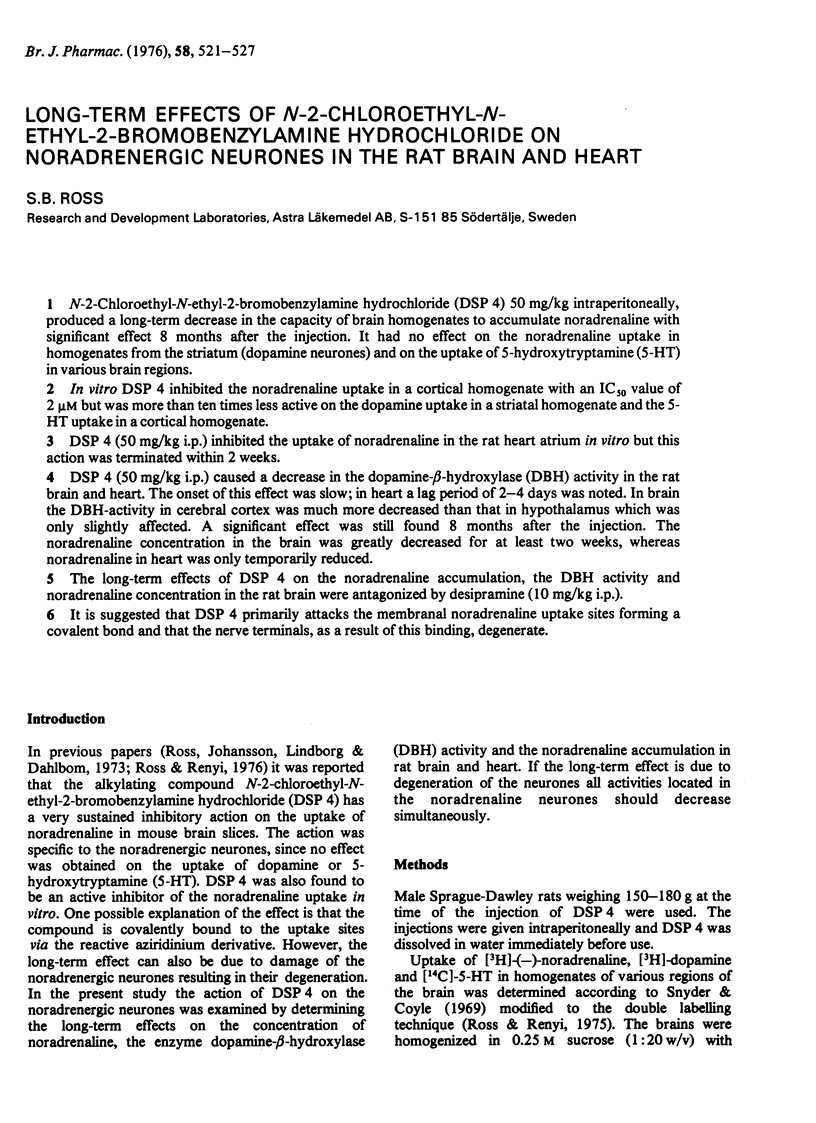
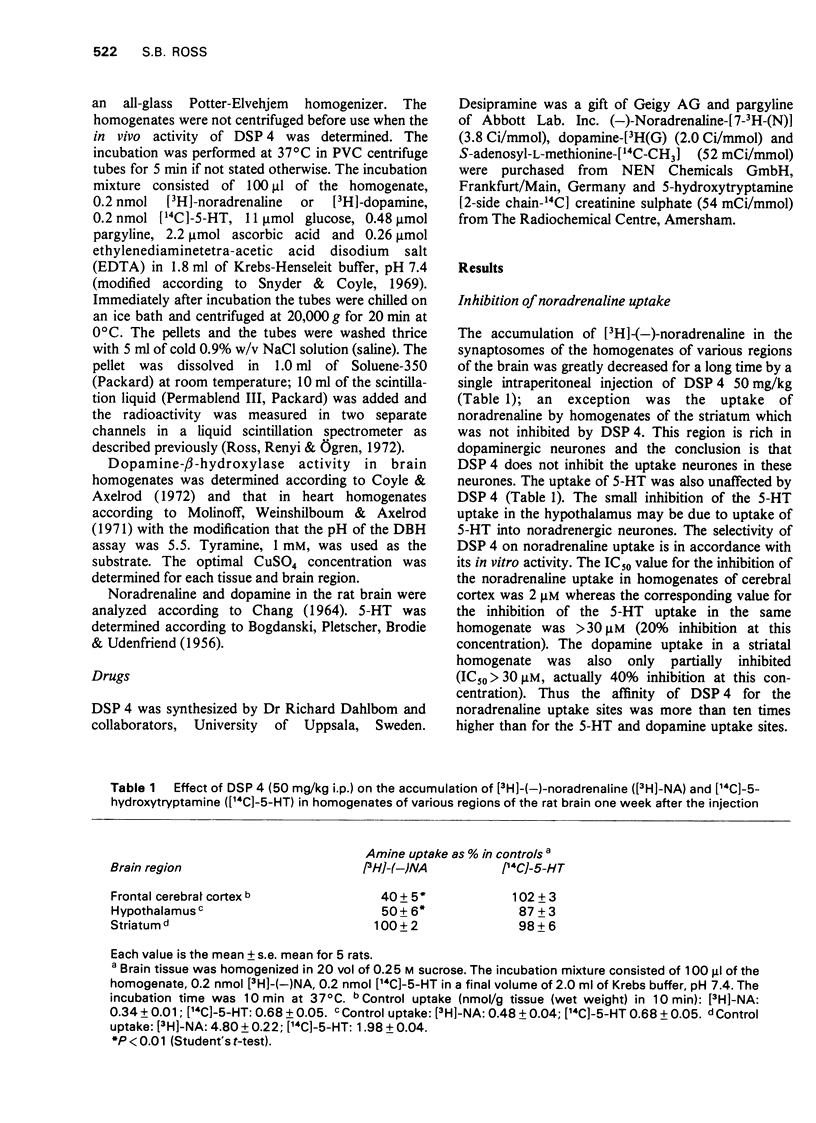
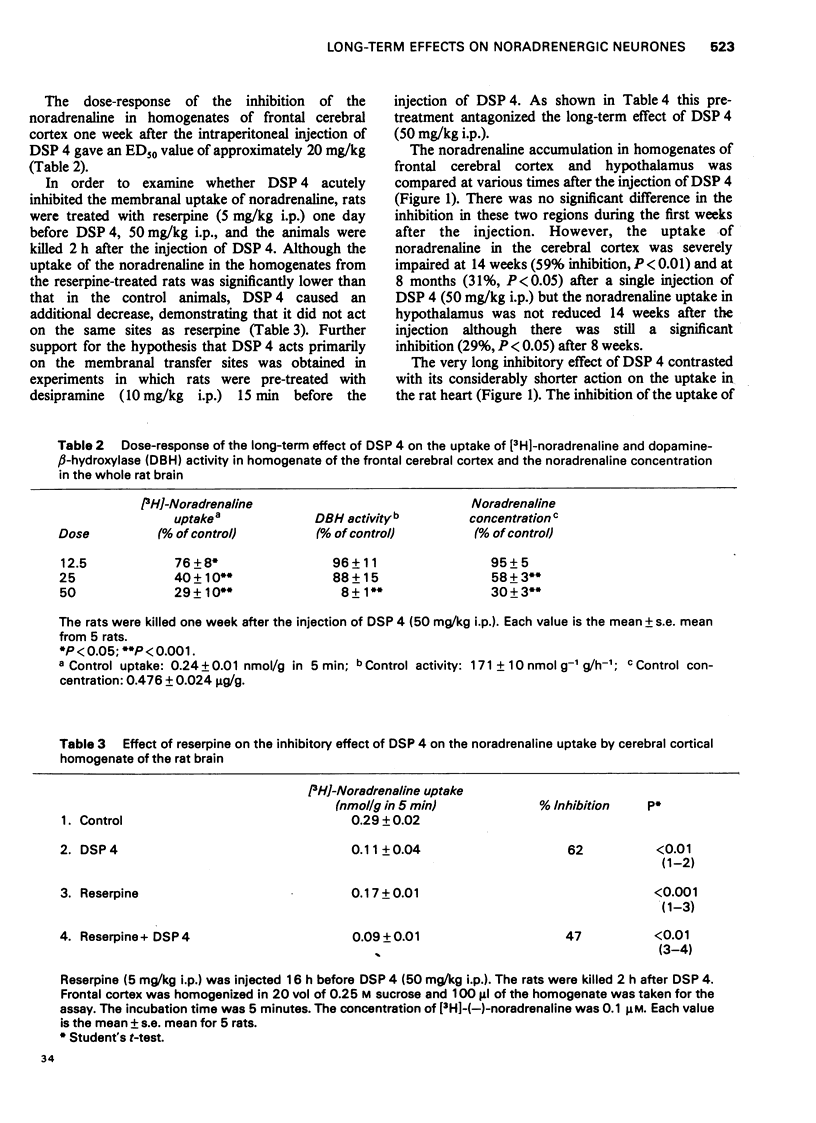
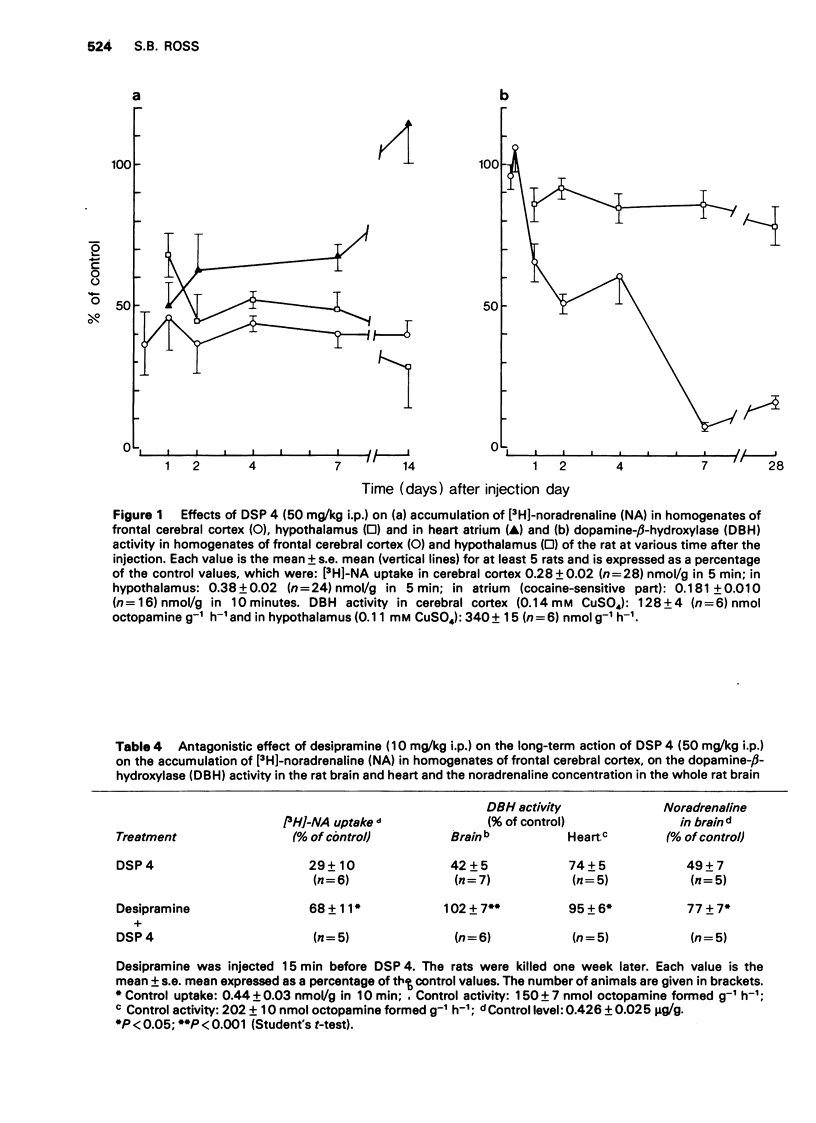
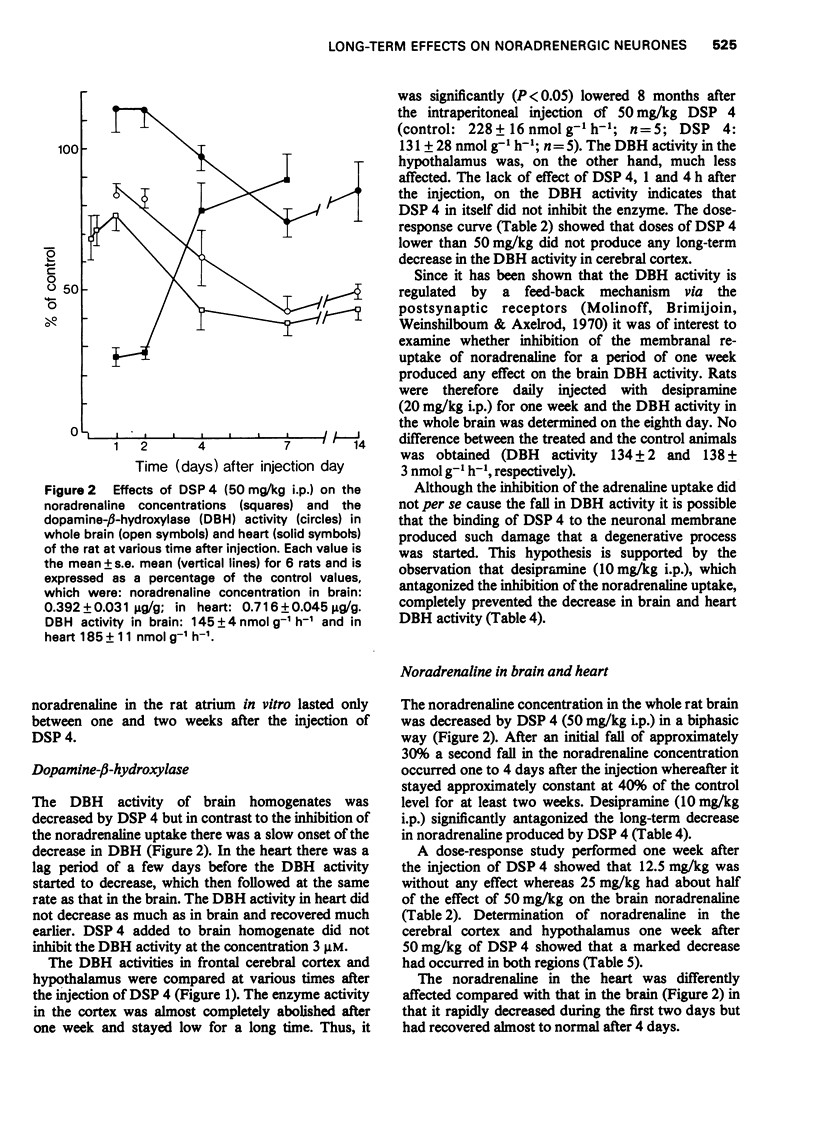

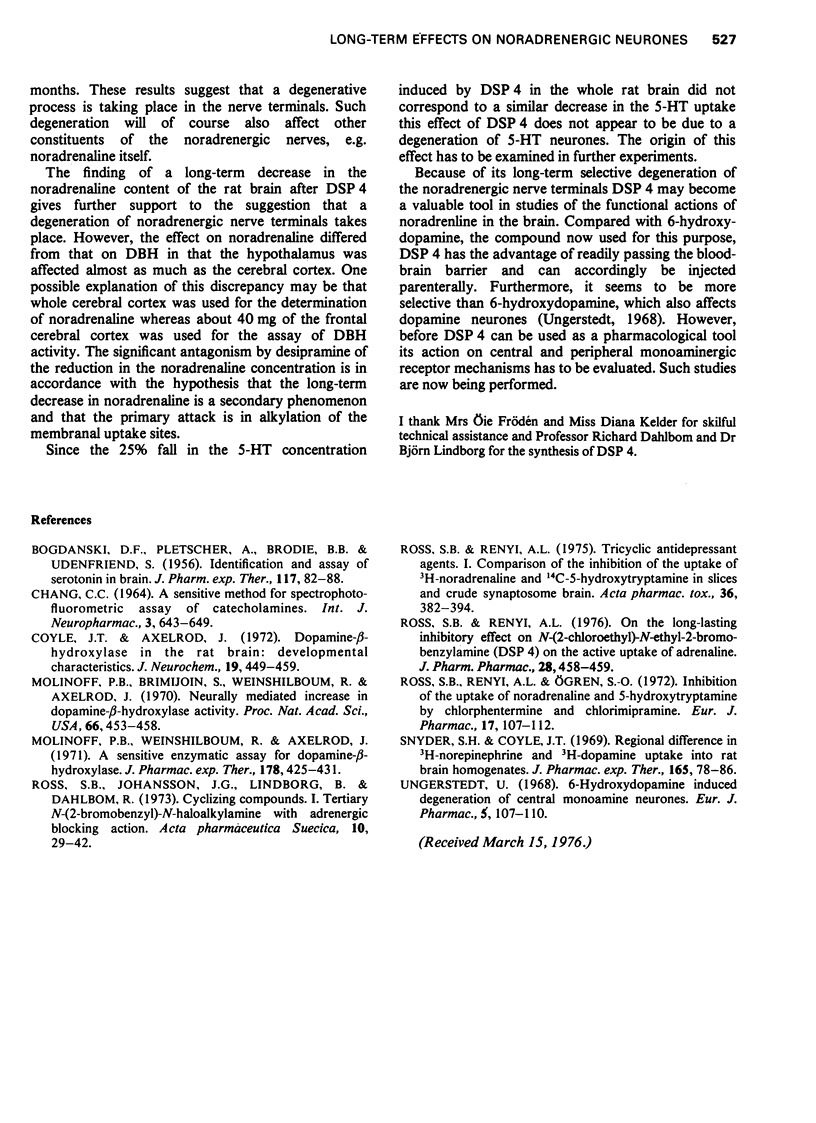
Selected References
These references are in PubMed. This may not be the complete list of references from this article.
- BOGDANSKI D. F., PLETSCHER A., BRODIE B. B., UNDENFRIEND S. Identification and assay of serotonin in brain. J Pharmacol Exp Ther. 1956 May;117(1):82–88. [PubMed] [Google Scholar]
- CHANG C. C. A SENSITIVE METHOD FOR SPECTROPHOTOFLUOROMETRIC ASSAY OF CATECHOLAMINES. Int J Neuropharmacol. 1964 Dec;3:643–649. doi: 10.1016/0028-3908(64)90089-9. [DOI] [PubMed] [Google Scholar]
- Coyle J. T., Axelrod J. Dopamine- -hydroxylase in the rat brain: developmental characteristics. J Neurochem. 1972 Feb;19(2):449–459. doi: 10.1111/j.1471-4159.1972.tb01354.x. [DOI] [PubMed] [Google Scholar]
- Molinoff P. B., Brimijoin S., Weinshilboum R., Axelrod J. Neurally mediated increase in dopamine-beta-hydroxylase activity. Proc Natl Acad Sci U S A. 1970 Jun;66(2):453–458. doi: 10.1073/pnas.66.2.453. [DOI] [PMC free article] [PubMed] [Google Scholar]
- Molinoff P. B., Weinshilboum R., Axelrod J. A sensitive enzymatic assay for dopamine- -hydroxylase. J Pharmacol Exp Ther. 1971 Sep;178(3):425–431. [PubMed] [Google Scholar]
- Ross S. B., Johansson J. G., Lindborg B., Dahlbom R. Cyclizing compounds. I. Tertiary N-(2-bromobenzyl)-N-haloalkylamines with adrenergic blocking action. Acta Pharm Suec. 1973 Mar;10(1):29–42. [PubMed] [Google Scholar]
- Ross S. B., Renyi A. L., Ogren S. O. Inhibition of the uptake of noradrenaline and 5-hydroxytryptamine by chlorphentermine and chlorimipramine. Eur J Pharmacol. 1972 Jan;17(1):107–112. doi: 10.1016/0014-2999(72)90276-2. [DOI] [PubMed] [Google Scholar]
- Ross S. B., Renyi A. L. Tricyclic antidepressant agents. I. Comparison of the inhibition of the uptake of 3-H-noradrenaline and 14-C-5-hydroxytryptamine in slices and crude synaptosome preparations of the midbrain-hypothalamus region of the rat brain. Acta Pharmacol Toxicol (Copenh) 1975;36(Suppl 5):382–394. doi: 10.1111/j.1600-0773.1975.tb00806.x. [DOI] [PubMed] [Google Scholar]
- Ross S. B., Renyl A. L. On the long-lasting inhibitory effect of N-(2-chloroethyl)-N-ethyl-2-bromobenzylamine (DSP 4) on the active uptake of noradrenaline. J Pharm Pharmacol. 1976 May;28(5):458–459. doi: 10.1111/j.2042-7158.1976.tb04659.x. [DOI] [PubMed] [Google Scholar]
- Snyder S. H., Coyle J. T. Regional differences in H3-norepinephrine and H3-dopamine uptake into rat brain homogenates. J Pharmacol Exp Ther. 1969 Jan;165(1):78–86. [PubMed] [Google Scholar]
- Ungerstedt U. 6-Hydroxy-dopamine induced degeneration of central monoamine neurons. Eur J Pharmacol. 1968 Dec;5(1):107–110. doi: 10.1016/0014-2999(68)90164-7. [DOI] [PubMed] [Google Scholar]


